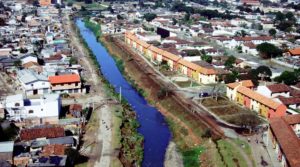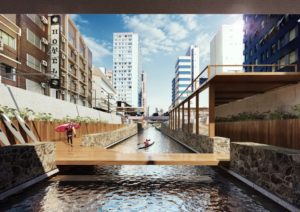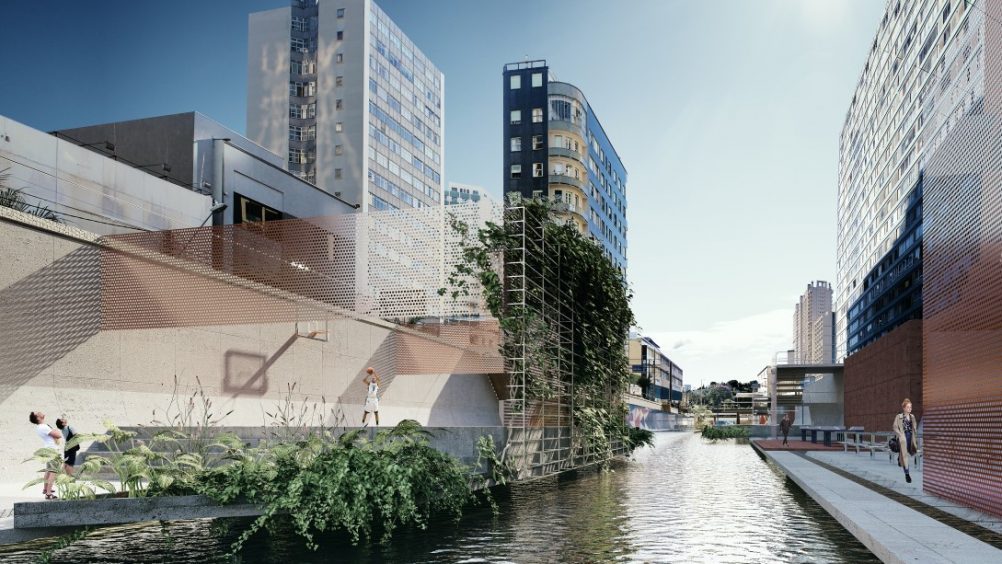For thousands of years, rivers have been a key factor in the location of cities. Whether for shipping, fishing, drinking water, irrigation, hydropower, and all of those ecosystem services combined, no other natural feature has been more attractive to city founders.
Rivers thus become a key element of local residents’ identity. So, what happens when that element is toxic, foul, and/or hidden from sight? REVITALIZATION has hundreds of article in its searchable archives documenting the global trends that are reconnecting people to their restored waterways, such as stream daylighting, removal of waterfront highways, etc. Hundreds—if not thousands—of towns and cities are being revitalized as a result of such projects.

Rio Belém in Curitiba. Photo: O Caminhante
Now, Solo Arquitetos, the city design office in Curitiba, Brazil, has suggested that their city should be next to benefit from the trend of restoring and reconnecting to urban waters.
They want to reopen channelized, over-engineered stretches of the Rio Belém and Rio Ivo, both of which run through the city center. The work was envisioned as part of the 2017 Architecture Exhibition for Curitiba, which is bringing together many design proposals to redesign and rethink the city.
“The city can take many paths. These spaces can be occupied in many different ways“, exhorted the architects of the project. “Many see the rivers as a problem to be solved, but we see in them as chance to restore the relationship of the citizens with their river, thus revitalizing the degraded city center.”
The architects partaking in the project include: Arthur Felipe Brizola, Gabriel Zem Schneider, João Gabriel Cordeiro Küster, and Thiago Augustus Prenholato Alves. They are joined by students Eduardo Sanches Salsamendi, Mariana Resende Sutil de Oliveira, Kauana Perdigão, Lucas Holmes, Paola Bucci Leal, Nágila Fernanda Hachmann, Larissa Angela Pereira da Silva, Jessica Tiemi Ouchi, Rafael Santos Ferraz, Franco Luiz Faust, and Lucas Aguillera.
 Though the rivers are currently choked with trash and fouled by both human and industrial waste, the architects envision a day when people will be swimming and boating in it, while relaxing or playing sports along restored banks with newly-created parks and gardens.
Though the rivers are currently choked with trash and fouled by both human and industrial waste, the architects envision a day when people will be swimming and boating in it, while relaxing or playing sports along restored banks with newly-created parks and gardens.
The Belém river is powerfully emblematic of Curitiba. It was not just central to the historical emergence of the city, but it’s unique in being a purely urban river. Like the Anacostia River of the Washington DC area, the Belém starts and ends within the metropolitan limits. The Rio Ivo is a key tributary of the Belém, transversing many important areas of the city.
The designers reveal at least six ways of reconnecting the river to Curitiba, as revealed in the renderings you see here.
Of course, simply reconnecting to them won’t suffice: they will need to be drastically cleaned and restored. An assessment from the Environmental Institute of Paraná reveals them to be heavily polluted.
But envisioning a city of beautiful, healthy rivers and canals—and well-designed connections to them—is a wonderful and necessary beginning to that worthy process.
All images courtesy of Solo Architects / Expo 2017, unless otherwise credited.

